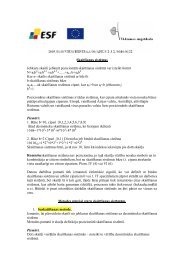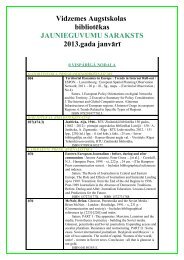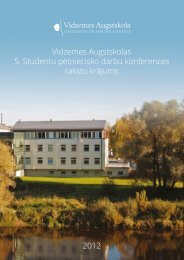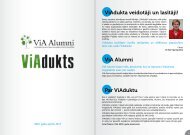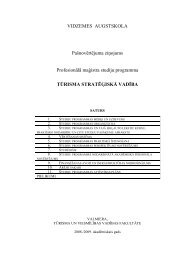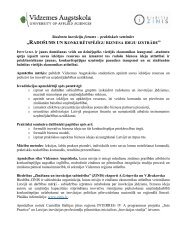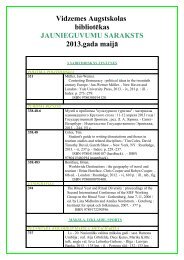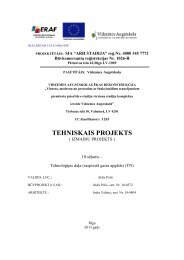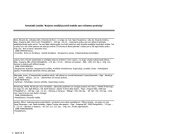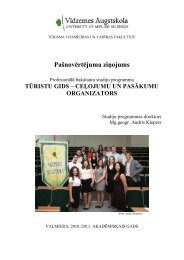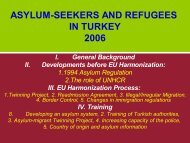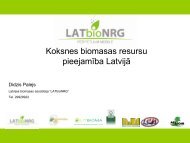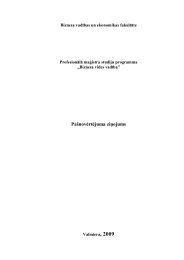Proceedings
Proceedings
Proceedings
Create successful ePaper yourself
Turn your PDF publications into a flip-book with our unique Google optimized e-Paper software.
Sustainable Planning Instruments and Biodiversity Conservation<br />
on this lek. At the same time, a long-drown flood in<br />
2007 caused the movement of Lek 1 to the non-flooded<br />
parts of the meadow that were situated at the distance<br />
of 800 m from the former lekking area. In 2008, high<br />
floods and the termination of cattle grazing at the<br />
place of Lek BR 1 led to the total disappearance of this<br />
lek. The birds probably moved to unidentified smaller<br />
leks due to the absence of optimal habitat. Similar<br />
occurrences took place in the Sporovsky Preserve,<br />
where a significant reduction of cattle pasture and<br />
mowing resulted in the total disappearance of<br />
substantial Great Snipe leks in 2008, when displaying<br />
of solitary birds was observed only.<br />
Conclusions<br />
The analysis of the conditions of the Black Grouse leks<br />
on the territories of the Belovezhskaya Puscha and the<br />
Berezinsky Reserve shows that the main reasons for the<br />
reduction of Black Grouse numbers are anthropogenic<br />
factors. Land reclamation and active agricultural use<br />
of the studied territories have negatively transformed<br />
natural habitats, which led to a sharp increase in the<br />
vulnerability of nests and hatches of the Black Grouse,<br />
frequently associated with an increase in the pressure<br />
by predators in the years of rodent depression. Hunting<br />
and poaching also causes a negative influence upon<br />
the number of the species. On the other hand, human<br />
activities may have positive influence. Stability of the<br />
display places is frequently maintained by mowing at the<br />
leks, which provides displaying birds a better view and,<br />
consequently, the best protection from predators.<br />
Parallel studies of the Great Snipe conducted on the<br />
territories of the Berezinsky Reserve and the National<br />
Park “Belovezhskaya Puscha” suggest that there is a<br />
rapid change in habitats of this species, and that in an<br />
extremely short period of time numerous biotopes<br />
may become unsuitable for this species. There is a<br />
strong necessity for rational biotope management on<br />
the protected territories. In particular, considerable<br />
decrease of the Great Snipe habitats is occurring due to<br />
termination of agricultural mowing and cattle grazing.<br />
Some alternative strategies for habitat management<br />
should be developed and implemented.<br />
References<br />
Auer G. 1898. Die jagd in Belowiechi. Jager Beit.<br />
Brincken Julius. 1828. Mémoire descriptif sur la forêt impériale<br />
de Białowieża en Lithuanie, redige por. Varsovie.<br />
Mongin, E. 2002. Snipes in Belarus. In: Snipes of the Eastern<br />
Baltic Region and Belarus. OMPO special publication.<br />
Pp. 15–35.<br />
Mongin, E. 2008. Great Snipe population, habitat management<br />
and conservation aspects in Belarus: a review.<br />
In: Economic, social and cultural aspects in biodiversity<br />
conservation (eds. Opermanis, O., Whitelaw, G.)<br />
The University of Latvia Press. Pp. 31–38.<br />
BirdLife International. 2004. Birds in Europe: populations estimates,<br />
trends and conservation status. Cambridge.<br />
Gavrin V. F. 1953. Materials on ecology of Tetraonidae in<br />
Belovezhskaya Puscha. Typescript. Kameniuki, 329 p. (In<br />
Russian)<br />
Gavrin V. F. 1956. Ecology of Tetraonidae of Belovezhskaya<br />
Puscha. Abstract of Ph.D. Thesis of Gavrin V. F. (candidate<br />
degree), Academy of Sciences of Kazakhstan SSR,<br />
Institute of Zoology, Alma-Ata. (In Russian)<br />
Datskevich V. A. 1971. Ornithofauna of Belovezhskaya Puscha<br />
and vicinities. In: Belovezhskaya Puscha. Researches, 5 th<br />
issue. Minsk: Uradzhai. Pp. 184–222. (In Russian)<br />
Dolbik M. S. 1974. Landscape structure of ornithofauna of<br />
Belarus. Minsk: Nauka I tekhnika. (In Russian)<br />
Dolbik M. S. 1975. Black Grouse. Tetraonidae birds, distribution,<br />
ecology, use and protection. Moscow: Nauka. (In<br />
Russian)<br />
Dolbik M. S. 1984. Modern conditions of Capercaillie and<br />
Black Grouse reserves in Byelorussia. In: Ways of increasing<br />
of efficiency of game-keeping activities in BSSR.<br />
Minsk. Pp. 15–16. (In Russian)<br />
Ivaniutenko A. N., Pareiko O. A., Bychkov V. P., Rafalovich<br />
T. I., Semashko I. I. 1992. Regularities of modern distribution<br />
and dynamics of the number of Capercaillie and<br />
Black Grouse in Byelorussia. Minsk, 18 p. Deposited in<br />
Institute of Zoology of Academy of Science of Belarus,<br />
Scientific Eco-center “Veras-Eco”, 18/09/1992, #113. (In<br />
Russian)<br />
Kartsov G. 1903. Belovezhskaya Puscha. St. Petersburg. (In<br />
Russian)<br />
Kirikov S. V., Mikheev A. V., Spangenberg E. P. 1952. Censuses<br />
of Galliformes. In: Methods of censuses and geographical<br />
distribution of ground vertebrates. Moscow: edition<br />
of Institute of Geography of the Academy of Sciences of<br />
USSR. Pp. 260–265. (In Russian)<br />
Popenko V. M., Datskevich V. A., Kolosey L. K. 1986.<br />
Modern composition and structure of ornithofauna<br />
of Belovezhskaya Puscha and vicinities. In: Report<br />
on scientific research work for 1983, 1984. Kameniuki. (In<br />
Russian)<br />
Potapov R. L. 1990. Birds of the grouse family (Tetraonidae).<br />
Leningrad University. (In Russian)<br />
Severtsev S. A. 1940. Belovezhskaya Puscha. Nature, 10. (In<br />
Russian)<br />
Fedyushin, A. and Dolbik, M. 1967. Birds of Belarus. Nauka i<br />
Tekhnika. (In Russian)<br />
Stralborg K. 1861. Propositions on European Bison and Game<br />
Protection in Belovezhskaya Puscha. National Historical<br />
Archive in Grodno. Fund #31. List 1 (add.). File 204. (In<br />
Russian)<br />
Spatial Planning and Bioenergy: Use of GIS Instruments<br />
ILZE NEIMANE 1 , JURIS ZARIŅŠ 2<br />
Abstract<br />
Use of biomass for heat and power production is considered to be one of the main driving forces in sustainable<br />
development. In opposition to fossil energy sources, which require centralized power production systems, use of<br />
biofuel is decentralized and closely linked with regional development planning.<br />
To consider bioenergy as a regional development factor and a spatial planning task, one of the preconditions is<br />
understanding and use of spatial planning instruments such as Geographical Information Systems (GIS).<br />
One of the tasks of GIS is to represent and visualize figures, thus making them easily identifiable. Information on<br />
biomass is also related to a territory, from the evaluation of resources to the utilization of biomass. The access to<br />
biomass information, calculation methods and utilization experience should be provided to interested persons in a<br />
way that embraces the field to the maximum and is simple at the same time. The end-user, who is the main consumer,<br />
most often is not a professional able to study the source of information.<br />
We can imagine GIS as a hand with five fingers – computer engineering, software, aim of application, geographical<br />
data, and trained personnel – without anyone of these, a wholesome GIS system cannot be imagined.<br />
1 Introduction<br />
The continuing global trends of limited fossil resources<br />
and climate change as leading environmental problems<br />
have raised the importance of using alternative energy<br />
sources, inter alia biomass, which is the most significant<br />
alternative energy source in the Baltic Sea region.<br />
Nonetheless, the use of bioenergy produced from biomass<br />
is decentralized in comparison with fossil sources and<br />
is strongly related to local decision-making processes.<br />
Moreover, in local decision-making processes, the use of<br />
bioenergy is considered more as a regional development<br />
factor instead of a solution for global environmental<br />
problems.<br />
Trade of bioenergy resources in the Baltic Sea region<br />
has grown on an international scale, thus advancing the<br />
issue of use of biomass resources for bioenergy production<br />
from the local to international aspect. Due to lack of local<br />
consumption of biomass by large-scale heating plants in<br />
Latvia, during the second part of the 1990s and the last<br />
decade, biofuel was mainly exported to Scandinavian<br />
countries. The highest export volume was reached in<br />
2006–2007. Local utilization of biofuel resources on a<br />
larger scale has begun only in the current decade, which<br />
has raised such issues as resource availability, economic<br />
efficiency, and sustainability.<br />
2 Methods<br />
GIS Instruments for Biomass Planning<br />
Since information on bioenergy production relates to a<br />
specific territory, beginning with the study, extraction<br />
and utilization of bioenergy, it is necessary to consider<br />
the aspects of the local use of such information –<br />
perception of information, the aim of application, choice<br />
of the data to use.<br />
One of the tasks of GIS is to visualize the calculated<br />
information, thus making it easily perceivable – numbers<br />
and figures alone are not the message that the end-user<br />
can perceive. In most cases, the end-user will not be a professional<br />
able to study sources of information, and even<br />
if there is some place to gather information on biomass,<br />
in each separate case it cannot be compared one to one<br />
with, for example, information gathered in the neighboring<br />
region. It is important to secure access to calculation<br />
models, end-use experience and other information important<br />
to the regional production and utilization of biomass<br />
to any interested person in a way that embraces the field<br />
to the maximum and is simple at the same time.<br />
We can analyze the aspects of implementation and use<br />
of GIS for bioenergy applications at the local level using<br />
the overall GIS definition – the hand with five fingers in<br />
case of the lack of any of which a wholesome system of<br />
GIS cannot be conceived. The two most simple parts of<br />
1<br />
State SIA “Vides Projekti”, Pils iela 17, Rīga, LV-1050, Latvia, e-mail: ilze.neimane@videsprojekti.lv<br />
2<br />
State Forest Service, 13. janvāra iela 15, Rīga, LV-1932, Latvia, e-mail: juris@vmd.gov.lv<br />
72<br />
73



